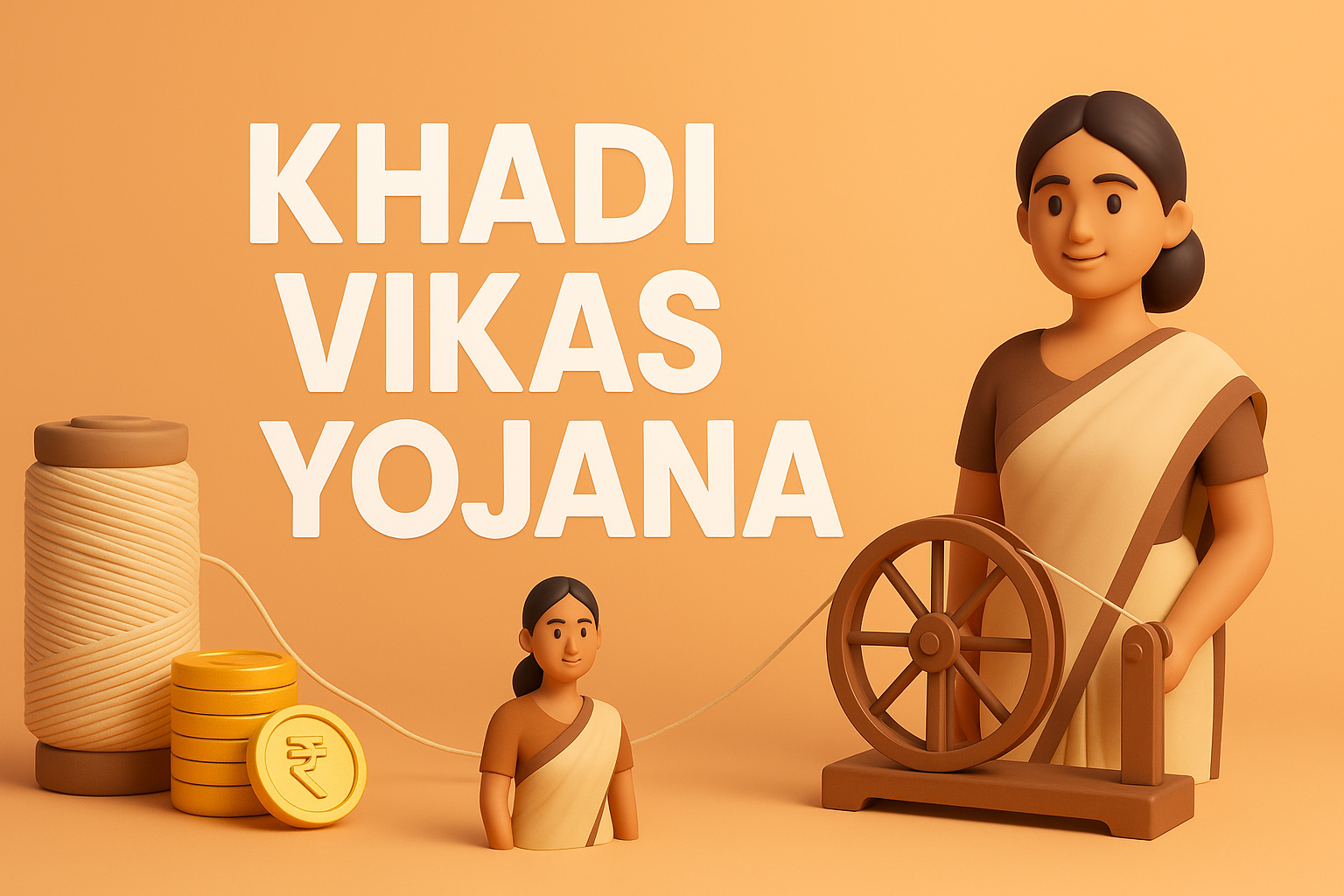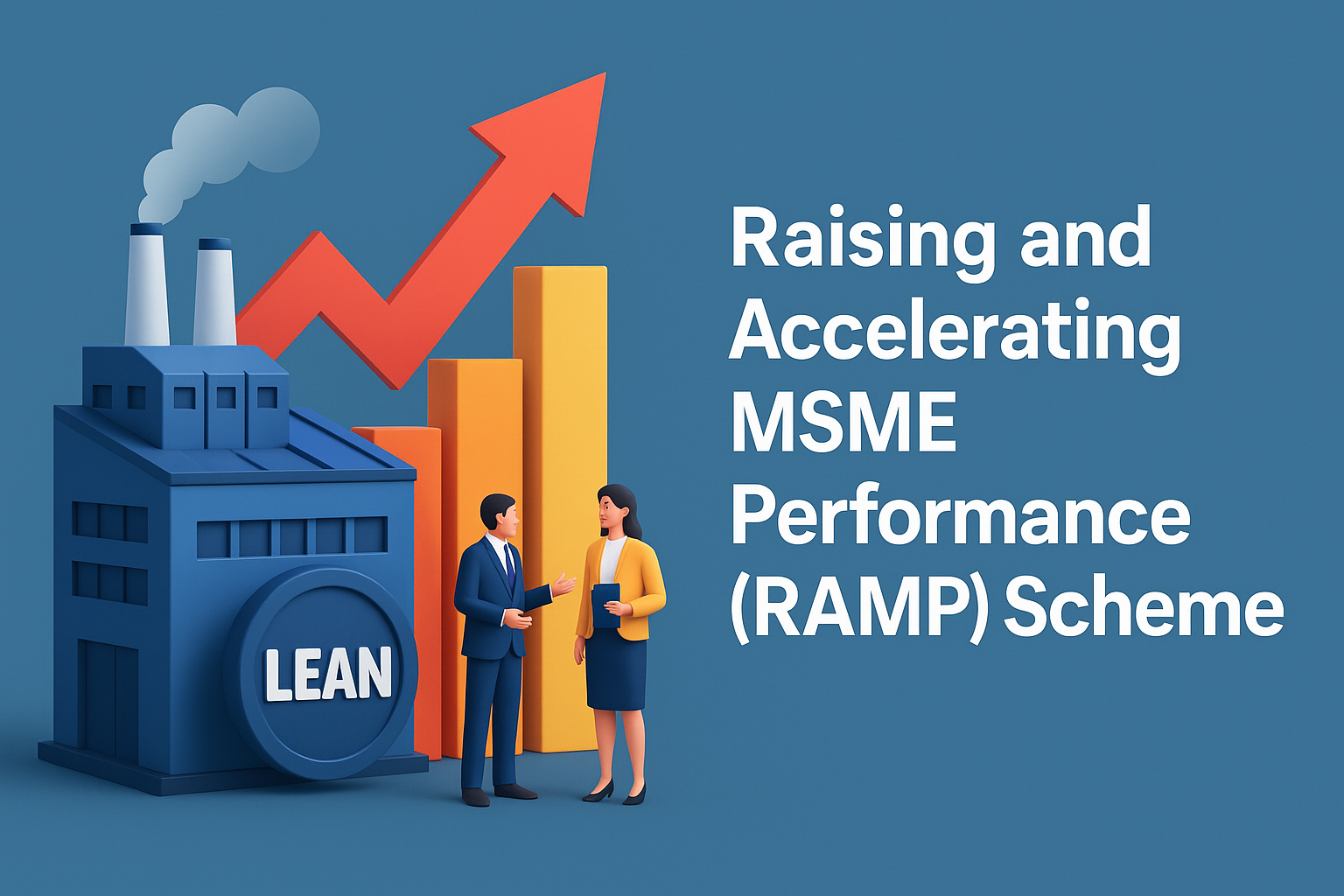Khadi, more than just a fabric, is a symbol of India’s self-reliance and rich cultural heritage. To ensure its continued relevance and prosperity, the Ministry of MSME, through the Khadi and Village Industries Commission (KVIC), introduced the Khadi Vikas Yojana (KVY). As a vital subcomponent of the broader Khadi Gramodyog Vikas Yojana, KVY is specifically dedicated to promoting and strengthening the khadi sector in India. Its core mission is to modernize khadi institutions, streamline production processes, and significantly enhance the welfare and earnings of the dedicated artisans.
This blog post will provide a comprehensive breakdown of how the Khadi Vikas Yojana actively supports khadi-producing units, traditional spinners, and weavers through targeted financial, infrastructural, and digital assistance. We will explore its objectives, key components, eligibility, and the step-by-step application process, equipping you with the knowledge to harness its full potential in 2025 and beyond.
Table of Contents
- What is Khadi Vikas Yojana?
- Key Objectives of KVY
- Core Components & Financial Assistance
- Eligibility Criteria for KVY Benefits
- Step-by-Step Application Process
- Benefits for Artisans and Institutions
- Common Mistakes to Avoid
- FAQs
- How Sigma Solutions Can Help
- Conclusion
What is Khadi Vikas Yojana?
The Khadi Vikas Yojana (KVY) is a central sector scheme, functioning under the larger umbrella of the Khadi Gramodyog Vikas Yojana, with a clear mandate to revitalize India’s traditional khadi industry. It serves as a comprehensive framework designed to:
- Improve the efficiency and quality of khadi production by integrating modern techniques with traditional craftsmanship.
- Ensure better and more regular earnings for khadi artisans, providing them with a sustainable livelihood.
- Digitally upgrade and modernize khadi institutions, enhancing their operational capabilities and market reach.
- Provide essential infrastructure and design support, from updated production facilities to contemporary product designs.
This ambitious scheme is meticulously run and implemented through KVIC’s extensive network of over 2,000 affiliated khadi institutions spread across India, connecting remote artisans to national markets.
Key Objectives of KVY
The Khadi Vikas Yojana 2025 sets forth a series of strategic objectives aimed at fostering a robust and thriving khadi ecosystem:
- Strengthen the Khadi Value Chain: From raw material sourcing to final product sales, ensuring efficiency and quality at every stage.
- Improve Yarn Productivity and Quality: Introducing advanced charkhas and looms to enhance the output and fineness of khadi yarn and fabric.
- Encourage Young Entrepreneurs in the Khadi Sector: Attracting and nurturing a new generation of business leaders to innovate and scale khadi enterprises.
- Provide Training and Market Access: Equipping artisans with updated skills and facilitating their access to broader domestic and international markets.
- Digitize Khadi Sales and Institutional Operations: Promoting e-commerce integration, digital payment solutions, and modern inventory management for institutions.
Core Components & Financial Assistance
The Khadi Vikas Yojana offers a variety of integrated components to achieve its goals, each with specific financial assistance mechanisms:
Modified Market Development Assistance (MMDA)
This is a crucial incentive designed to make khadi products more competitive. Under MMDA, an incentive of 30% on the prime cost of production is provided. This assistance is strategically split:
- 20% goes directly to the artisans (spinners and weavers) as an incentive, enhancing their take-home wages.
- 10% goes to the khadi institutions to improve marketing, renovate sales outlets, and offer customer-friendly promotions.
- Recent Updates (2024-25 data): KVIC has recently released substantial MMDA grants, benefiting a large number of khadi institutions and over 1.46 lakh artisans. Spinners’ wages have also seen a significant increase, further boosting artisan income.
Interest Subsidy Eligibility Certificate (ISEC)
The ISEC scheme aims to reduce the financial burden of working capital. It offers a reimbursement of 4% interest on working capital loans availed by khadi institutions from banks. KVIC directly pays the difference between the actual lending rate and 4% to the banks, ensuring institutions only pay a concessional rate.
Infrastructure Support
KVY provides grants for the renovation, modernization, and establishment of khadi outlets and production centers. This includes support for building improvements, acquiring modern tools, and creating better workshed environments for artisans. The scheme offers financial assistance for:
- Individual Worksheds: Up to ₹1,20,000 or 75% of the construction cost.
- Group Worksheds: Up to ₹80,000 per artisan (for a group of minimum 5, maximum 15 artisans) or 75% of the construction cost.
- Revival of Weak Khadi Institutions: Financial aid up to ₹15 lakh for struggling institutions.
- Renovation of Sales Outlets: Up to ₹25 lakh for KVIC, KVIB, and institutional sales units.
Training & Capacity Building
This component focuses on upskilling artisans, promoting technology adoption, and developing managerial capabilities within khadi institutions. It includes:
- Free technical training sessions.
- Entrepreneurship Development Programs (EDPs).
- Specialized training in modern production techniques and quality control.
Digitalization Grants
Recognizing the need for a digital leap, KVY offers grants for:
- Point of Sale (POS) systems for retail outlets.
- Billing software to streamline transactions.
- E-commerce integration to help khadi institutions sell their products online, leveraging platforms like the MSME-GeM portal.
- Provision of tech kits and training for digital literacy.
Eligible Institutions and Individuals
The Khadi Vikas Yojana is designed to support various stakeholders within the khadi ecosystem:
- Registered Khadi Institutions (KIs): These are the primary beneficiaries, provided they are affiliated with KVIC or State Khadi and Village Industries Boards (KVIBs) and hold valid Khadi certificates.
- Artisans/Spinners/Weavers: Individuals actively engaged in certified khadi production are beneficiaries, though they must be linked with a registered khadi institution.
- NGOs or Societies: Organizations with proper khadi certification and a proven track record in the khadi sector.
- Youth-led Enterprises: Specific encouragement and support are provided to new ventures and young entrepreneurs venturing into the khadi sector, particularly under initiatives like the Khadi Reform Package.
Application Process
The application process for the Khadi Vikas Yojana primarily flows through the Khadi institutions:
- Application by Khadi Institution: The registered khadi institution initiates the application process, typically through its respective KVIC regional office.
- Submission of Documents: Institutions must submit comprehensive documentation, including:
- Audited financial accounts.
- Detailed lists and Aadhaar-seeded bank details of associated artisans.
- Valid khadi production certificates.
- Specific proposals for MMDA, interest subsidy, or infrastructure/training support.
- Screening and Verification: Applications undergo thorough screening and verification by KVIC or the relevant State Khadi and Village Industries Board.
- Fund Disbursement/Direct Benefit Transfer: Upon approval, funds are disbursed to the institution, or direct benefits (like artisan incentives) are transferred directly to artisan bank accounts (through DBT).
Benefits for Artisans and Institutions
The Khadi Vikas Yojana delivers a wide array of tangible benefits for both the hardworking artisans and the institutions striving to keep khadi alive:
- Regular Income and Increased Production Efficiency: Through modernization and incentives like MMDA, artisans experience more consistent work and better wages, while institutions see improved output.
- Financial Incentives for Production and Working Capital: Direct financial boosts and reduced interest burdens make operations more viable.
- Modernized Infrastructure and Tools: Access to upgraded charkhas, looms, and improved worksheds enhances comfort, productivity, and product quality.
- Participation in Fairs and Marketing Events: Opportunities to showcase products at national and international exhibitions, expanding market reach.
- Recognition as Certified Khadi Producer: Enhanced brand value and consumer trust through official certification.
- Digital Empowerment: E-commerce capabilities open new sales channels, connecting khadi to a global customer base.
Common Mistakes to Avoid
To ensure a smooth experience and maximize benefits under the KVY, institutions and artisans should be aware of these common pitfalls:
- Submitting Incomplete or Outdated Artisan Lists: Accurate and verified data for all artisans is crucial for incentive disbursement.
- Not Maintaining Required Production Standards: Adherence to KVIC’s quality and production norms is essential for certification and continued eligibility.
- Missing Bank Details or Account Verification Documents: Ensure all bank account details, especially for Direct Benefit Transfer (DBT), are accurate and verified.
- Delay in Submitting MMDA Utilization Reports: Timely submission of utilization certificates and reports is vital for continued financial assistance and transparency.
FAQs
Here are answers to some frequently asked questions about the Khadi Vikas Yojana:
Q1. What exactly is Modified Market Development Assistance (MMDA)?
MMDA is a direct incentive calculated as 30% of the prime cost of certified khadi production. It’s designed to boost sales by providing a financial cushion, with 20% directly benefiting the artisans and 10% going to the institution for marketing and infrastructure.
Q2. Can individual artisans apply directly for the scheme’s benefits?
No. Artisans must be affiliated with and apply through a registered khadi institution that is certified by KVIC or a State KVIB. Benefits like MMDA are often routed through the institution, with the artisan’s share directly transferred to their Aadhaar-seeded bank accounts.
Q3. What is the key benefit of the Interest Subsidy Eligibility Certificate (ISEC)?
The ISEC scheme allows khadi institutions to avail working capital loans from banks while only paying a concessional interest rate of 4%. KVIC covers the remaining interest amount, significantly reducing the financial burden on institutions.
Q4. Is training mandatory for new khadi institutions or artisans joining the network?
Yes. Training programs, especially those focusing on technical skills, quality control, and digital literacy, are strongly encouraged and often made mandatory for new institutions and artisans. This ensures compliance with standards and improves market readiness.
Q5. Can khadi products be sold online with support from the scheme?
Yes. The Khadi Vikas Yojana actively supports e-commerce enablement through digitalization grants. This includes assistance for setting up POS systems, integrating with online platforms, and training for online sales, allowing khadi products to reach a wider customer base.
How Sigma Solutions Can Help
Sigma Solutions is committed to supporting the growth and modernization of India’s cherished khadi sector. We assist khadi entrepreneurs and institutions with end-to-end guidance to effectively leverage the Khadi Vikas Yojana 2025:
- Project Report Drafting and Application Filing: Comprehensive support in preparing detailed project reports and accurately filing applications for various scheme components.
- Affiliation with KVIC and Khadi Certification: Guidance through the process of getting affiliated with KVIC and obtaining essential khadi certifications.
- MMDA Claim Documentation: Expert assistance in preparing and submitting accurate documentation for Modified Market Development Assistance claims.
- Digital Transformation and POS Setup: Helping institutions embrace digitalization, including setting up Point of Sale (POS) systems and e-commerce integration.
- Skill Training Facilitation and Compliance: Connecting artisans and institutions with relevant training programs and ensuring ongoing compliance with scheme guidelines and reporting requirements.
Conclusion
The Khadi Vikas Yojana 2025 stands as a powerful bridge between India’s cherished textile traditions and the demands of modern enterprise. By providing a much-needed boost in technology, funding, and market reach, it ensures the khadi sector continues to thrive and contributes significantly to rural livelihoods. This scheme is not just about financial aid; it’s about preserving a cultural heritage while empowering a new generation of artisans and entrepreneurs.
If you are a khadi artisan, a weaving collective, or an institution dedicated to the craft, this scheme offers a golden opportunity to scale your operations, enhance your product quality, and expand your market presence. Let Sigma Solutions be your trusted partner to help you unlock the full potential of the Khadi Vikas Yojana and secure your place in India’s growing handmade economy.






